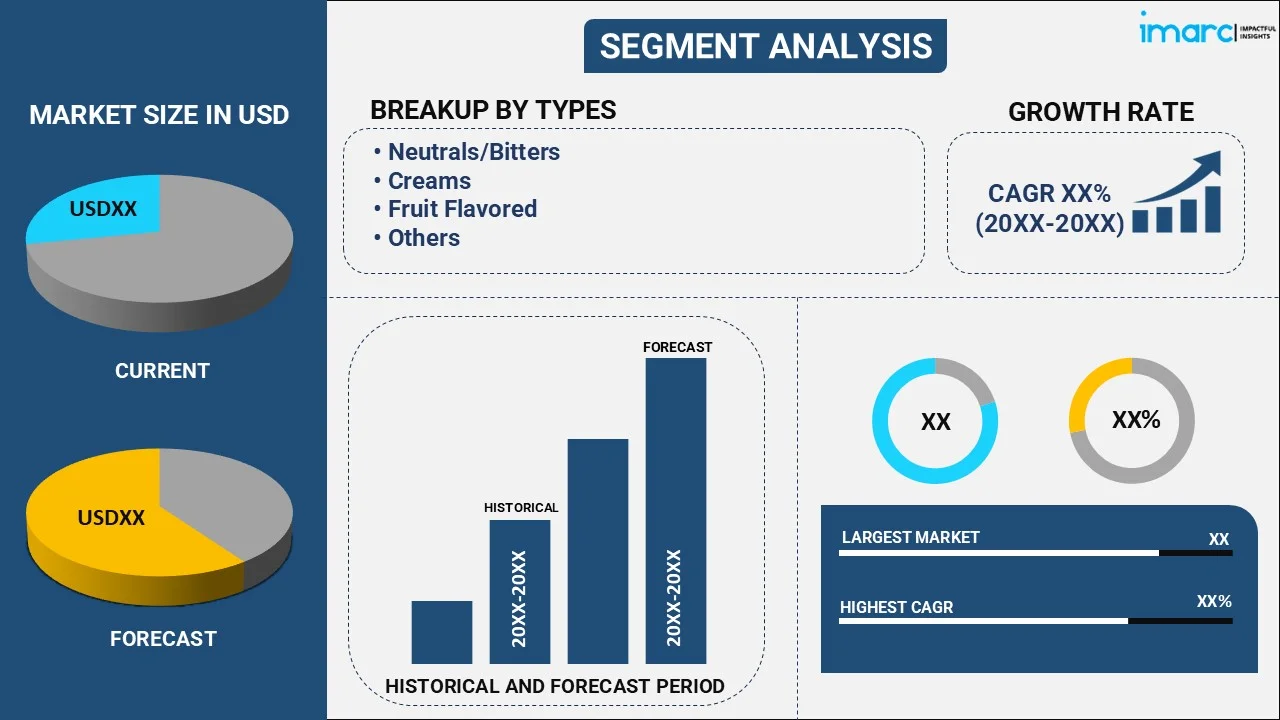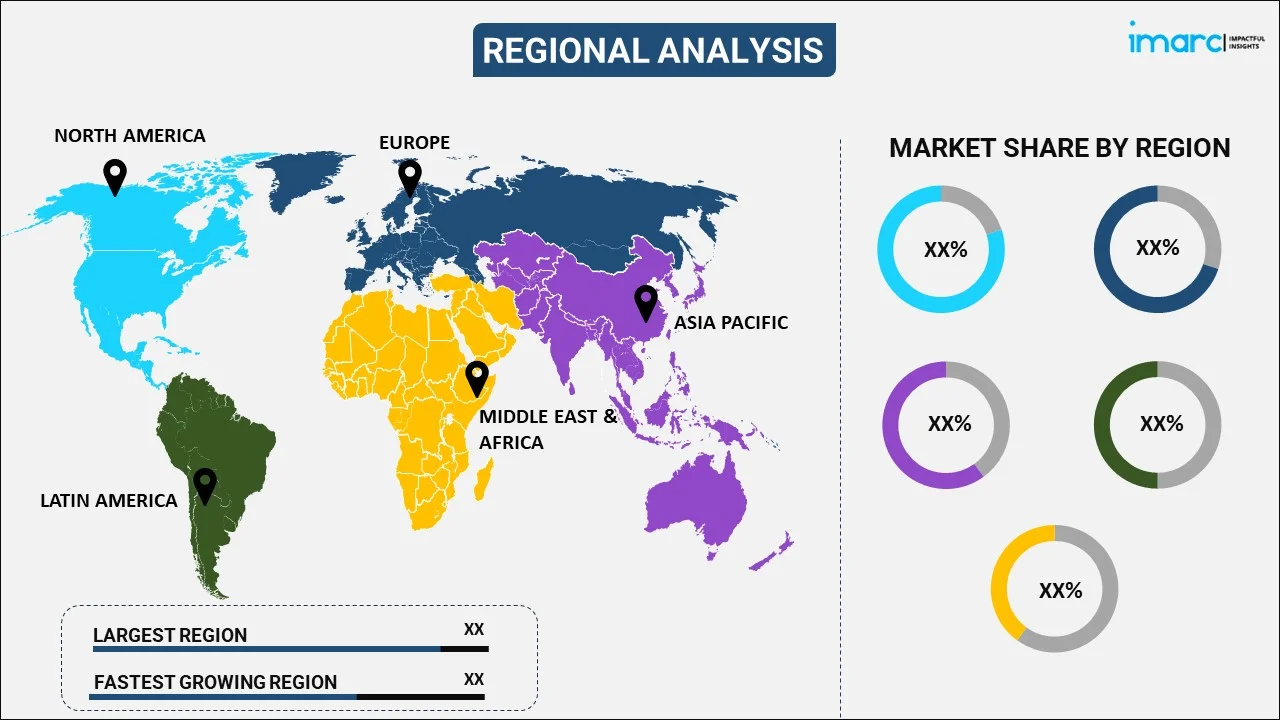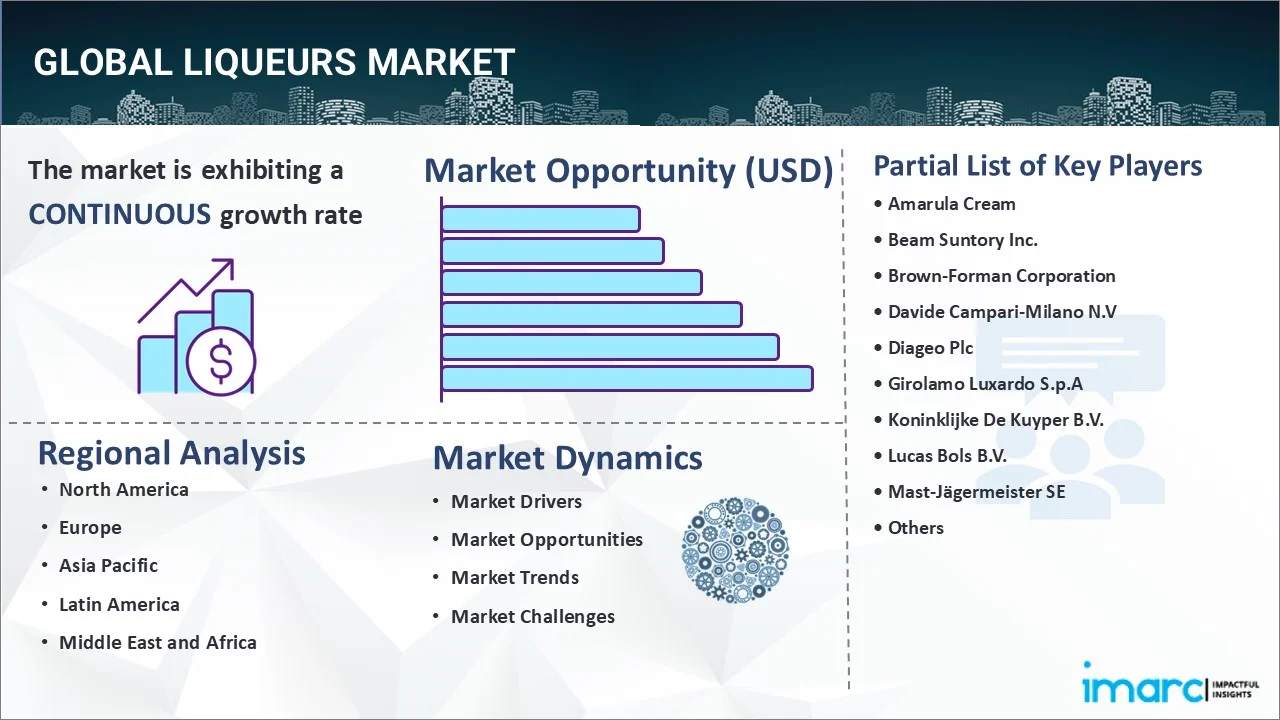
Liqueurs Market Report by Type (Neutrals/Bitters, Creams, Fruit Flavored, and Others), Packaging Type (Glass, PET Bottle, Metal Can, and Others), Distribution Channel (On-Trade, Off-Trade), and Region 2025-2033
Market Overview:
The global liqueurs market size reached USD 131.3 Billion in 2024. Looking forward, IMARC Group expects the market to reach USD 164.0 Billion by 2033, exhibiting a growth rate (CAGR) of 2.38% during 2025-2033. The growing demand for high-quality liqueur beverages and rising adoption of flavored liqueurs in tequila-based cocktails are impelling the market growth. Another market trend responsible for substantial growth is the continuous launch of novel product variants.
|
Report Attribute
|
Key Statistics
|
|---|---|
|
Base Year
|
2024
|
|
Forecast Years
|
2025-2033
|
|
Historical Years
|
2019-2024
|
| Market Size in 2024 | USD 131.3 Billion |
| Market Forecast in 2033 | USD 164.0 Billion |
| Market Growth Rate (2025-2033) | 2.38% |
Liqueurs, also known as cordials, refer to flavored and diluted forms of liquors with a sweet taste and an alcohol content ranging from 15 to 30 percent by volume. They are prepared by mixing a base spirit, such as vodka, rum, or brandy, with fruits or herbs, which is then sweetened by adding sugar or syrup. They can be aged or bottled instantly and flavored using additional ingredients, including herbs, fruits, and oils. They are commonly available in different types, such as fruit, plant, and generic or flavored liqueurs. They can be either served straight, poured over ice, or mixed in numerous combinations comprising liquors, brandies, and cream. Liqueurs are often consumed neat or on rocks as an after-dinner drink and also used as flavorings in various dessert dishes due to their sweet taste. Besides this, they serve as the modifier or perfume of a cocktail and are added to coffee. As a result, liqueurs have gained immense popularity as recreational beverages owing to their alcohol content.
Liqueurs Market Trends:
Shifting Consumer Preferences and Rising Demand for Premium Liqueurs
As per the liqueurs market research, the consumer preference for premium alcoholic beverages is rising, primarily due to higher disposable incomes, rapid urbanization, and improving living standards. This trend is particularly prominent among young adults, who are increasingly drawn to high-quality liqueurs. As this demographic seeks unique, indulgent experiences, the demand for premium drinks has heightened. Additionally, flavored liqueurs, particularly those used in tequila-based cocktails, are becoming more popular due to their bold and distinctive taste. These beverages offer a diverse flavor palette, appealing to consumers seeking enhanced, sophisticated drinking experiences, which further drives market growth for premium liqueur brands and products.
Exotic Fruit-Based Liqueurs and Social Acceptance
The increasing popularity of fruit-based liqueur cocktails, featuring exotic flavors such as orange, cherries, apple, plum, and melon, is driving market growth. These vibrant flavors appeal to consumers seeking unique and refreshing drink options, making them a popular choice at social events. In emerging nations, alcohol consumption is becoming more socially accepted, leading to a rise in liqueur usage at gatherings such as weddings, parties, and graduations. Additionally, the growing number of hotels, pubs, bars, and restaurants offering alcoholic beverages has improved accessibility, further contributing to the expanding demand for liqueur-based cocktails in these settings.
Innovative Strategies by Manufacturers
Manufacturers are actively diversifying their product offerings by introducing new liqueur varieties and enhancing their packaging with sustainable, visually appealing designs. This focus on eco-friendly packaging aligns with growing consumer demand for sustainability. Additionally, marketing campaigns are being deployed to reach a wider audience, boosting brand visibility and appeal. Beyond beverages, liqueurs are increasingly being used in bakery and confectionery products, expanding their applications. Their role as appetizers also adds to their versatility. Continuous product innovation, such as the development of unique flavors and formats, is expected to drive further market expansion and attract a broader range of consumers.
Key Market Segmentation:
IMARC Group provides an analysis of the key trends in each segment of the global liqueurs market report, along with forecasts at the global, regional and country levels from 2025-2033. Our report has categorized the market based on type, packaging type and distribution channel.
Type Insights:

- Neutrals/Bitters
- Creams
- Fruit Flavored
- Others
The report has provided a detailed breakup and analysis of the liqueurs market based on the type. This includes neutrals/bitters, creams, fruit flavored, and others. According to the report, neutrals/bitters represented the largest segment.
Packaging Type Insights:
- Glass
- PET Bottle
- Metal Can
- Others
A detailed breakup and analysis of the liqueurs market based on the packaging type has also been provided in the report. This includes glass, PET bottle, metal can, and others. According to the report, glass accounted for the largest market share.
Distribution Channel Insights:
- On-Trade
- Off-Trade
- Hypermarkets and Supermarkets
- Grocery Stores
- Convenience Stores
- Others
The report has provided a detailed breakup and analysis of the liqueurs market based on the distribution channel. This includes on-trade and off-trade (hypermarkets and supermarkets, grocery stores, convenience stores, and others. According to the report, off-trade represented the largest segment.
Regional Insights:

- North America
- United States
- Canada
- Asia-Pacific
- China
- Japan
- India
- South Korea
- Australia
- Indonesia
- Others
- Europe
- Germany
- France
- United Kingdom
- Italy
- Spain
- Russia
- Others
- Latin America
- Brazil
- Mexico
- Others
- Middle East and Africa
The report has also provided a comprehensive analysis of all the major regional markets, which include North America (the United States and Canada); Asia-Pacific (China, Japan, India, South Korea, Australia, Indonesia, and others); Europe (Germany, France, the United Kingdom, Italy, Spain, Russia, and others); Latin America (Brazil, Mexico, and others); and the Middle East and Africa.
Competitive Landscape:
The report has also provided a comprehensive analysis of the competitive landscape in the global liqueurs market. Detailed profiles of all major companies have also been provided. Some of the companies covered include:
- Amarula Cream
- Beam Suntory Inc.
- Brown-Forman Corporation
- Davide Campari-Milano N.V
- Diageo Plc
- Girolamo Luxardo S.p.A
- Koninklijke De Kuyper B.V.
- Lucas Bols B.V.
- Mast-Jägermeister SE
- Pernod Ricard SA
- Remy Cointreau
- Sazerac Company
- Stock Spirits Group
Kindly note that this only represents a partial list of companies, and the complete list has been provided in the report.
Liqueurs Market News:
- 10 September 2024: Sir Edmond Gin, a leading Dutch liqueur label, has established a partnership with Netherlands-based SAR Liquors, a global distributor of alcoholic beverages. SAR Liquors will acquire a stake in Sir Edmond Gin as part of the agreement, becoming a company shareholder.
- 26 April 2023: HEINEKEN N.V. has announced the completion of its acquisition of Distell Group Holdings Limited (‘Distell’) and Namibia Breweries Limited (‘NBL’), which have been combined with HEINEKEN South Africa into a new HEINEKEN majority-owned business to capture significant growth opportunities in Southern Africa.
Report Coverage:
| Report Features | Details |
|---|---|
| Base Year of the Analysis | 2024 |
| Historical Period | 2019-2024 |
| Forecast Period | 2025-2033 |
| Units | Billion USD |
| Types Covered | Neutrals/Bitters, Creams, Fruit Flavored, Others |
| Packaging Types Covered | Glass, PET Bottle, Metal Can, Others |
| Distribution Channels Covered |
|
| Regions Covered | Asia Pacific, Europe, North America, Latin America, Middle East and Africa |
| Countries Covered | United States, Canada, Germany, France, United Kingdom, Italy, Spain, Russia, China, Japan, India, South Korea, Australia, Indonesia, Brazil, Mexico |
| Companies Covered | Amarula Cream, Beam Suntory Inc., Brown-Forman Corporation, Davide Campari-Milano N.V, Diageo Plc, Girolamo Luxardo S.p.A, Koninklijke De Kuyper B.V., Lucas Bols B.V., Mast-Jägermeister SE, Pernod Ricard SA, Remy Cointreau, Sazerac Company, Stock Spirits Group, etc. |
| Customization Scope | 10% Free Customization |
| Post-Sale Analyst Support | 10-12 Weeks |
| Delivery Format | PDF and Excel through Email (We can also provide the editable version of the report in PPT/Word format on special request) |
Key Questions Answered in This Report:
- How has the global liqueurs market performed so far, and how will it perform in the coming years?
- What are the drivers, restraints, and opportunities in the global liqueurs market?
- What is the impact of each driver, restraint, and opportunity on the global liqueurs market?
- What are the key regional markets?
- Which countries represent the most attractive liqueurs market?
- What is the breakup of the market based on the type?
- Which is the most attractive type in the liqueurs market?
- What is the breakup of the market based on the packaging type?
- Which is the most attractive packaging type in the liqueurs market?
- What is the breakup of the market based on distribution channel?
- Which is the most attractive distribution channel in the liqueurs market?
- What is the competitive structure of the global liqueurs market?
- Who are the key players/companies in the global liqueurs market?
Key Benefits for Stakeholders:
- IMARC’s report offers a comprehensive quantitative analysis of various market segments, historical and current market trends, market forecasts, and dynamics of the liqueurs market from 2019-2033.
- The research study provides the latest information on the market drivers, challenges, and opportunities in the global liqueurs market.
- The study maps the leading, as well as the fastest-growing, regional markets. It further enables stakeholders to identify the key country-level markets within each region.
- Porter's five forces analysis assist stakeholders in assessing the impact of new entrants, competitive rivalry, supplier power, buyer power, and the threat of substitution. It helps stakeholders to analyze the level of competition within the liqueurs industry and its attractiveness.
- Competitive landscape allows stakeholders to understand their competitive environment and provides an insight into the current positions of key players in the market.
Need more help?
- Speak to our experienced analysts for insights on the current market scenarios.
- Include additional segments and countries to customize the report as per your requirement.
- Gain an unparalleled competitive advantage in your domain by understanding how to utilize the report and positively impacting your operations and revenue.
- For further assistance, please connect with our analysts.

 Inquire Before Buying
Inquire Before Buying
 Speak to an Analyst
Speak to an Analyst
 Request Brochure
Request Brochure
 Request Customization
Request Customization




.webp)




.webp)












